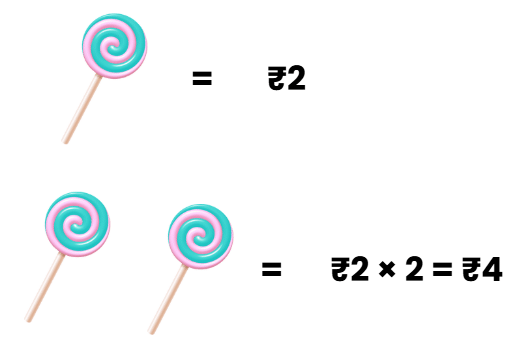Everyday Mathematics: Money | Mathematics Olympiad for Class 1 PDF Download
Q1. If a candy costs ₹2, how much do 2 candies cost?
(a) ₹2
(b) ₹4
(c) ₹6
(d) ₹8
Ans: (b) ₹4
Multiply the cost of 1 candy by 2: ₹2 × 2 = ₹4.
This follows the multiplication method in the notes (e.g., ₹5 × 3 = ₹15).
Q2. Convert 750 paise into rupees.
(a) ₹7.50
(b) ₹0.75
(c) ₹75.00
(d) ₹7.05
Ans: (a) ₹7.50
To convert paise to rupees, separate the last two digits for paise: 750 paise = 7 rupees (700 paise) and 50 paise, written as ₹7.50.
Q3. You have ₹10.25, and you spend ₹4.15. How much money is left?
(a) ₹6.00
(b) ₹6.10
(c) ₹5.90
(d) ₹6.20
Ans: (b) ₹6.10
Subtract: ₹10.25 - ₹4.15. Paise: 25 - 15 = 10p.
Rupees: 10 - 4 = 6.
Total: ₹6.10.
Q4. A toy costs ₹15.60, and you add ₹20.30 more to buy another. What is the total cost?
(a) ₹35.90
(b) ₹36.90
(c) ₹35.80
(d) ₹36.00
Ans: (a) ₹35.90
Add: ₹15.60 + ₹20.30. Paise: 60 + 30 = 90p.
Rupees: 15 + 20 = 35.
Total: ₹35.90.
Q5. A pen costs ₹8.50. How much do 3 pens cost?
(a) ₹24.50
(b) ₹25.00
(c) ₹25.50
(d) ₹26.00
Ans: (c) ₹25.50
Multiply: ₹8.50 × 3 = 850 × 3 = 2550 paise.
Place the dot after two digits from the right: ₹25.50, per the multiplication method in the notes.
Q6. You have ₹50.75, and your friend has ₹29.45. How much more money do you have?
(a) ₹20.30
(b) ₹21.30
(c) ₹20.20
(d) ₹21.20
Ans: (b) ₹21.30
Subtract: ₹50.75 - ₹29.45. Paise: 75 - 45 = 30p.
Rupees: 50 - 29 = 21. Total: ₹21.30, similar to Example 6 in the notes.
Q7. A juice costs ₹12.25. How much would 4 juices cost?
(a) ₹48.00
(b) ₹49.00
(c) ₹48.50
(d) ₹49.50
Ans: (b) ₹49.00
Multiply: ₹12.25 × 4 = 1225 × 4 = 4900 paise.
Place the dot: ₹49.00, following the multiplication rule in the notes.
Q8. You have 1,200 paise, and you spend ₹8.50. How many paise do you have left?
(a) 350 paise
(b) 300 paise
(c) 400 paise
(d) 450 paise
Ans: (a) 350 paise
Convert ₹8.50 to paise: 8 × 100 + 50 = 850 paise.
Subtract: 1200 - 850 = 350 paise.
Q9. A book costs ₹45.90, and a toy costs ₹27.65. What is the total cost if you buy both?
(a) ₹73.55
(b) ₹73.45
(c) ₹72.55
(d) ₹73.65
Ans: (a) ₹73.55
Add: ₹45.90 + ₹27.65.
Paise: 90 + 65 = 155p (1 rupee + 55p).
Rupees: 45 + 27 + 1 = 73. Total: ₹73.55.
Q10. A shopkeeper has ₹100.00. He sells a shirt for ₹65.25 and a cap for ₹28.95. How much money is left?
(a) ₹5.80
(b) ₹6.80
(c) ₹5.70
(d) ₹6.70
Ans: (a) ₹5.80
Total spent: ₹65.25 + ₹28.95.
Paise: 25 + 95 = 120p (1 rupee + 20p). Rupees: 65 + 28 + 1 = 94.
Total: ₹94.20. Left: ₹100.00 - ₹94.20 = ₹5.80.
|
29 videos|109 docs|65 tests
|
FAQs on Everyday Mathematics: Money - Mathematics Olympiad for Class 1
| 1. What is the importance of money in our daily lives? |  |
| 2. How do we earn money? |  |
| 3. What are the different forms of money? |  |
| 4. Why is saving money important? |  |
| 5. How can we manage our money wisely? |  |

















